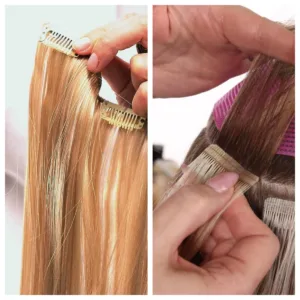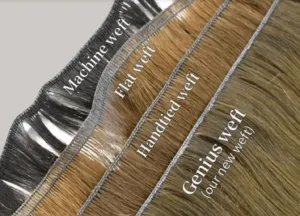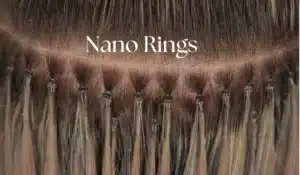When you invest in hair extensions, envisioning a luscious and vibrant mane, encountering dryness and frizz can be quite disheartening. Before you consider tossing them out, it’s crucial to understand why this happens and how you can breathe life back into them.And for salons, rough, puffy extensions drain client trust and add costly rework. Teams need clear answers, fast fixes, and a repeatable care plan that protects installs and margins.
Extensions turn dry and frizzy from low-grade materials, harsh processing, missing scalp oils, heat, UV, hard water, chlorine, salt, friction, wrong products, and late maintenance. Use premium hair, smart chemistry, and strict routines to keep them soft.
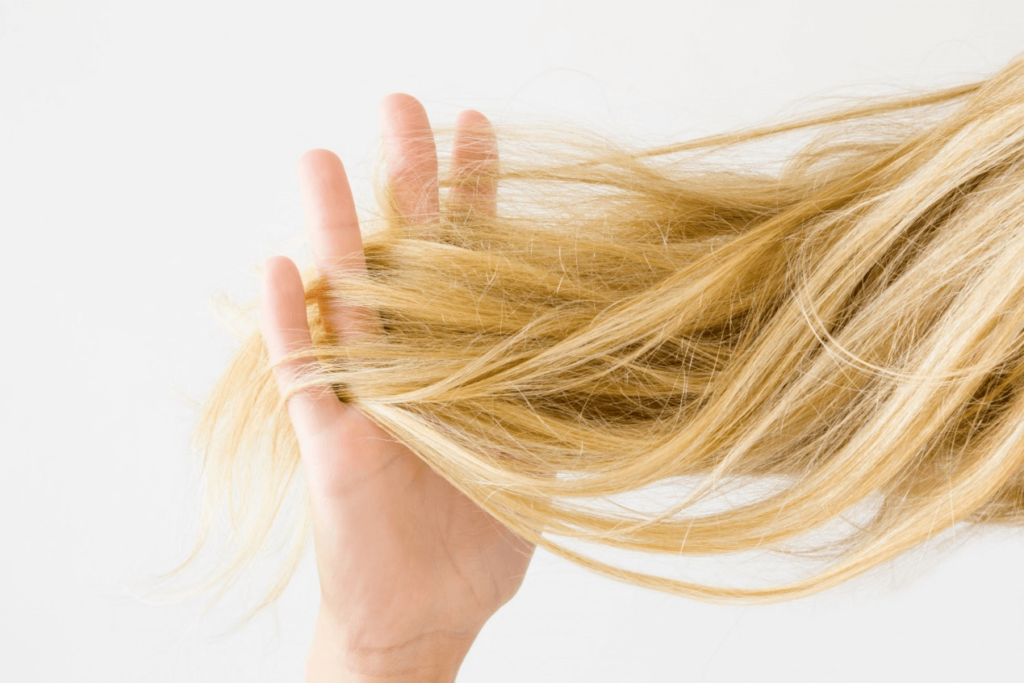
This guide explains every main cause, shows a step-by-step home rescue, builds a daily SOP, clarifies when to use oils, and details raw hair materials at a manufacturer level. The goal is simple: fewer callbacks, longer wear, and happier clients.
Why my hair extensions are dry and frizzy?
Clients report frizz after a few washes or a beach trip. The root cause is rarely one thing. It is a stack of small stressors that add up.
Dryness and frizz come from material limits, cuticle loss, product buildup, mineral scale, UV, salt, chlorine, high heat, rough handling, and delayed move-ups. Identify the mix on day one, then remove, repair, and protect.
Dive deeper
Material and processing realities
- Cuticle condition drives slip. Intact cuticles give glide and shine. Stripped cuticles create friction and tangles.
- Acid baths remove cuticles fast. Hair looks smooth at first but degrades quickly.
- Silicone coatings (dimethicone, amodimethicone) can mask roughness. After 3–6 shampoos the coating thins. The fiber then feels dry.
- Over-lightened stock has weaker cortex and faded 18-MEA lipids. Blondes dry out faster and need strict care.
Biology and friction
- Extensions lack sebum. Natural oils do not travel down added hair. Ends dry first.
- Friction sources: cotton pillowcases, collars, gym straps, and scarves lift the cuticle.
- Late maintenance creates shed-hair mats above bonds, beads, or rows. Mats feel rough and catch brushes.
Water, sun, and chemistry
- Hard water leaves calcium and iron on hair. The film feels squeaky-stiff and dull.
- Chlorine and salt strip moisture and roughen cuticle edges.
- UV breaks color molecules and dries fibers.
- Sunscreen stains: chemical SPFs with Avobenzone or Octocrylene can turn blondes pink/orange, then ends feel rubbery and dry.
Product and habit mistakes
- High-sulfate, high-pH cleansers pull moisture fast.
- Alcohol-heavy aerosols used daily cause chronic dryness.
- Protein overload (keratin/rice protein weekly) makes hair crispy.
- 430°F irons scorch tips.
- Sleeping wet creates tight mats that never feel smooth.
Use a decision map: strip minerals → feed moisture → seal ends → adjust tools → book maintenance. This sequence solves 80% of cases without replacing the hair asset.

how to make hair extensions soft again at home
Clients want relief today. The rescue must be safe for tapes, keratin, beads, and weft rows.
Run a three-phase reset at home: chelate minerals, refill moisture, then seal and protect. Keep all rich products away from attachments.
Dive deeper
The 7-step “Sunday Reset”
- Dry detangle: Support roots with one hand. Use a loop or soft mixed-bristle brush. Start at ends and move up.
- Chelate build-up: Wash once with a chelating shampoo (look for EDTA or citrate). Focus on scalp and between attachments. Rinse well. Weekly if you have hard water.
- Hydration mask: Towel-blot to damp. Apply a rich mask to mids–ends only (avoid tapes, bonds, beads, stitch lines by 2–3 cm). Clip and cap for 15–20 minutes.
- pH close (optional): Rinse, then pour through a quick acidic rinse (1 tbsp apple cider vinegar in 1 cup water). Rinse again. This smooths cuticles and adds shine.
- Leave-in + serum: Spray a lightweight leave-in. Apply a pea-size silicone serum (amodimethicone/dimethicone) on the last 10–15 cm only.
- Dry with intent: Aim airflow down the shaft. Low–medium heat. Keep direct heat off tapes, bonds, beads, and stitches.
- Dusting trim (optional): If ends are white or split, ask a stylist for a micro trim. Sealed ends hold moisture longer.
Method-specific notes
- Tape-ins: Oils and masks lift tapes. Keep a clean buffer zone.
- Keratin/Fusion: Do not clamp irons near bonds during reset week.
- I-tip/Nano: Keep beads clean and free of slip agents.
- Weft rows: Do not saturate stitches; focus on lengths.
When reset fails
If the fiber stays rough after two resets, you face heavy mineral scale or material fatigue. Book professional chelation + clear gloss, or plan a material upgrade to full cuticle hair for long-term stability.

how to care hair extensions daily
Good habits beat repairs. A simple routine prevents most frizz and tangles.
Brush morning and night. Wash 2–3× weekly. Keep roots clean and dry. Feed mids–ends. Sleep protected. Book move-ups on time.
Dive deeper
Daily and weekly SOP
- AM: Brush ends → roots while supporting attachments. Mist a light leave-in on mids–ends.
- Workout: Low braid or ponytail. After, dry roots and brush.
- Wash days (2–3×/week):
- Shampoo scalp with sulfate-free. Let suds slide through lengths.
- Condition mids–ends only. Detangle with a wide-tooth comb while conditioner sits.
- Cool rinse. Towel-press, never rub.
- Leave-in + small serum on ends.
- Blow-dry roots fully to protect attachments.
- PM: Ensure hair is dry. Loose braid or silk scrunchie. Sleep on a silk pillowcase.
Heat, tools, and styling
- Max temp: 180–200°C (350–390°F).
- Always use heat protectant.
- Avoid direct heat on tapes, bonds, beads, and stitches.
- Curl from mid-shaft down to reduce stress at attachments.
Swim, sun, and hard water
- Pre-wet with tap water, add leave-in, then braid.
- Rinse and chelate after pool or sea days.
- Wear a hat. Use mineral SPF on exposed skin near the hair.
- Install a shower filter and replace cartridges on schedule.
Maintenance cadence (on-head wear)
- Tape-ins: 6–8 weeks.
- Beaded/Sewn wefts: 6–10 weeks.
- I-tips/Nano: 8–12 weeks.
- Keratin/Fusion: 12–20 weeks.
Pre-book move-ups at install to prevent leverage and mats.

Should I oil my hair extensions every day?
Daily oiling sounds helpful. It often causes slip, dust attraction, and dullness.
Do not oil every day. Use a light serum or oil 2–4× per week on the last 10–15 cm only. Keep all oils away from tapes, bonds, beads, and stitches.
Dive deeper
Emollients vs sealants
- Emollients (esters, light oils) soften the surface.
- Silicones seal and reduce friction. Amodimethicone targets damaged areas and resists heavy build-up.
- Heavy natural oils can migrate to attachments and loosen systems.
Safe zones and spacing
| Method | Keep oils away by | Notes |
|---|---|---|
| Tape-in | 2–3 cm | Oils soften adhesive |
| Keratin/Fusion | 1–2 cm | Avoid bond swelling |
| I-tip/Nano | 1–2 cm | Keep beads clean |
| Weft rows | Off stitch line | Prevent stitch loosening |
Cadence: after wash days and one mid-week touch-up. If hair feels gummy, pause oils, chelate once, then restart with less product.
Product picks
- Light oils: squalane, C13-15 alkane, fractionated coconut (ends only).
- Serums: amodimethicone + trimethylsiloxysilicate blends for humidity control.
- Do not mist strong alcohol sprays daily. They dry fibers fast.
Hair raw materials and lifespan explained (manufacturer level)
Material decides most outcomes before install. Clear sourcing language protects brands and sets fair lifespans.
Choose the grade by cuticle integrity, donor pattern, and processing. Understand acid baths, silicone coatings, and single-donor consistency before you promise wear time.
Dive deeper
Non-Remy hair (budget, short wear)
- Source: Mixed salon floor cuttings from different donors, bundled after collection.
- Cuticles: Mixed directions; tangling risk is high without heavy processing.
- Processing: Acid bath strips cuticles to reduce friction; heavy silicone coating masks roughness.
- Result: Feels silky at first. After 3–6 washes the coating thins, tangles rise, and ends dry.
- Lifespan: 1–3 months with careful care.
- Use case: Low-budget, short campaigns. High after-sales risk.
Remy hair (mid-market, moderate wear)
- Source: Aligned bundles where cuticles face the same direction. Often multi-donor.
- Processing: Usually a slight acid bath and light silicone to even feel.
- Result: Natural look and better slip than Non-Remy. Some batch variation.
- Lifespan: 3–5 months with proper care.
- Use case: Mid-tier lines and price-sensitive projects.
Full cuticle grade hair (luxury, long wear)
- Source: Ponytails cut directly from a single young donor. One pack uses one donor only for texture and color consistency.
- Cuticles: 100% intact and aligned from root to tip.
- Processing: No acid bath; no silicone coating. Gentle cleansing and tone work only.
- Result: Strong cortex, stable color work, soft feel, and low friction over time.
- Lifespan: About 1 year with proper care.
- Use case: Luxury salons and premium brands seeking best cost-per-wear and least after-sales work.
At-a-glance comparison
| Grade | Donor pattern | Cuticles | Processing | Coating | Styling tolerance | Typical lifespan |
|---|---|---|---|---|---|---|
| Non-Remy | Mixed, salon floor | Mixed | Acid bath | Heavy silicone | Low after washes | 1–3 mo |
| Remy | Multi-donor aligned | Same direction | Slight acid | Light silicone | Moderate | 3–5 mo |
| Full cuticle | Single donor ponytail | Intact & aligned | No acid | No silicone | High | ~12 mo (often 12–24 mo) |
Business note: Full cuticle raises unit cost but lowers claim rates, saves chair time, and improves reviews. Cost-per-wear is usually the lowest at scale.

Product chemistry: what fixes or worsens frizz?
Formula choice makes or breaks softness. Teams should read labels and control pH, surfactants, and add-ons.
Avoid harsh surfactants, daily alcohol aerosols, sea-salt sprays, and constant protein masks. Choose chelators, cationic conditioners, targeted silicones, and moderate humectants.
Dive deeper
Avoid or limit
- Sulfates: Sodium lauryl/laureth sulfate strip moisture.
- High-pH clarifiers weekly: Use only for detox events.
- Alcohol-heavy sprays daily: Dryness and static.
- Sea-salt texture sprays: Immediate frizz on porous ends.
- Protein every week: Crispy feel on lightened fibers.
- Overused purple shampoos: Dry, brittle blondes.
Prefer and why
- Chelators: EDTA/citrate to remove calcium/iron.
- Sulfate-free blends: Gentle amphoteric + ionic pairs keep moisture.
- Cationic conditioners: Behentrimonium methosulfate or cetrimonium chloride add slip without weight.
- Silicones that target damage: Amodimethicone deposits where needed, then resists heavy buildup.
- Humectants in moderation: Glycerin, propanediol help in normal humidity; reduce in very dry climates.
Quick diagnostic flow
- Feels stiff and dull? Chelate once.
- Feels rough but clean? Moisture mask + amodimethicone serum.
- Feels crispy? Reduce protein, add moisture.
- Looks stringy/gummy? Pause oils, chelate, lighter leave-in.
- Still rough after 2 cycles? Pro chelation + gloss or replace material.
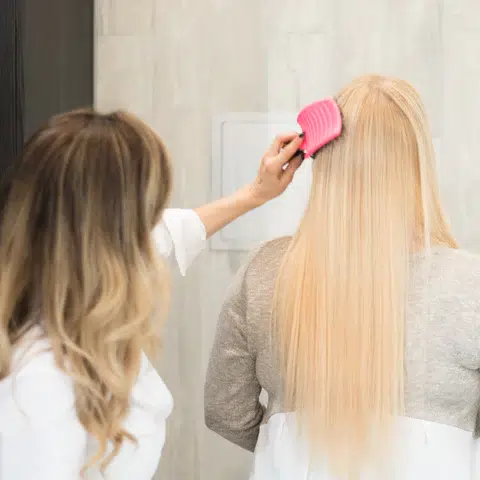
When home fixes fail: salon protocols and replacement policy
Some fibers are at end-of-life. Fast escalation saves time and protects hair.
Run a structured rescue, audit attachments, document findings, and decide on a controlled replacement with a material upgrade.
Dive deeper
In-salon rescue menu
- Chelation basin service: EDTA cleanse, gentle massage between attachments, thorough rinse.
- Acidic gloss/clear glaze: Close cuticles and add slip without heavy oils.
- Dusting trim: Remove micro splits to stop fray spread.
- Attachment audit:
- Tapes: check contamination; replace adhesive.
- Weft rows: verify bead tension and stitch spacing.
- I-tips/Nano: confirm bead integrity and mapping.
- Keratin: remove levered bonds; resection with correct load.
- Tone control for blondes: Gentle demi only; avoid strong lifts on extension hair.
Replacement triggers
- White, singed tips and ongoing breakage.
- Persistent roughness after two home resets and one pro chelation.
- Elasticity loss that snaps on gentle stretch.
- Severe mineral staining that will not lift.
Policy and documentation
- Photograph mapping at install and at each visit.
- Log water quality, swim/sun exposure, and product use.
- If replacing, upgrade to full cuticle single-donor. Set a written care plan and maintenance schedule to protect the new asset.
My opinion
From a manufacturer and supplier view, material decides most outcomes. Full cuticle, single-donor hair reduces friction, improves color control, and survives more move-ups. Pair premium material with a clear SOP: chelate weekly in hard water, moisture mask weekly, silicone seal on ends, strict heat limits, and on-time maintenance. This playbook lowers claims, protects client hair, and lifts cost-per-wear for salons and brands.
FAQ
Why do extensions feel great at first, then rough?
Silicone masking can hide damage. After a few washes it fades. Chelate, rehydrate, and seal. If roughness remains, the material is likely Non-Remy or over-processed.
Do blondes always dry out faster?
Lightening weakens the cortex and removes lipids. Blondes need lower heat, more moisture, and strict UV and sunscreen rules.
How often should I chelate?
Weekly in hard-water areas or during swim season. Monthly otherwise, or as needed.
Can I air-dry?
Yes for lengths, but always dry roots and attachments to prevent slip and odor.
What brush is best?
Loop or soft mixed-bristle. Support attachments with your hand. Brush morning and night.
Is daily oil safe?
No. Use oils or serums 2–4× weekly on the last 10–15 cm only. Keep away from attachments.
Do tapes fail because of conditioners?
Conditioners and oils at the root can contaminate adhesive. Keep a clean buffer zone.
My blonde ends turned pink/orange. What happened?
Likely contact with Avobenzone or Octocrylene sunscreens, or mineral buildup. Switch to mineral SPF, chelate, and tone if needed.
What heat is safe?
180–200°C (350–390°F) with protectant. Keep irons off attachments.
How long should premium hair last?
Full cuticle single-donor hair often lasts 1year across reuses with proper care.
Does protein help or hurt?
Small amounts can help. Weekly strong protein makes hair crispy. Balance with moisture.
When should I replace the hair?
After failed resets and pro chelation, persistent roughness, or clear fiber fatigue. Upgrade material to cut future issues.
Conclusion
Softness comes from premium material, smart chemistry, low friction, and on-time maintenance. Remove minerals, rehydrate, seal ends, and protect attachments to stop frizz at the source.
where to buy high quality hair extensions
Hibiscus Hair Manufacturer has been dedicated to producing high-quality hair extensions for 25 years and is a recognized leader in the industry. If you are interested in finding a reliable hair extensions supplier and wholesale for your brand, please visit our website for more information:
HOME

